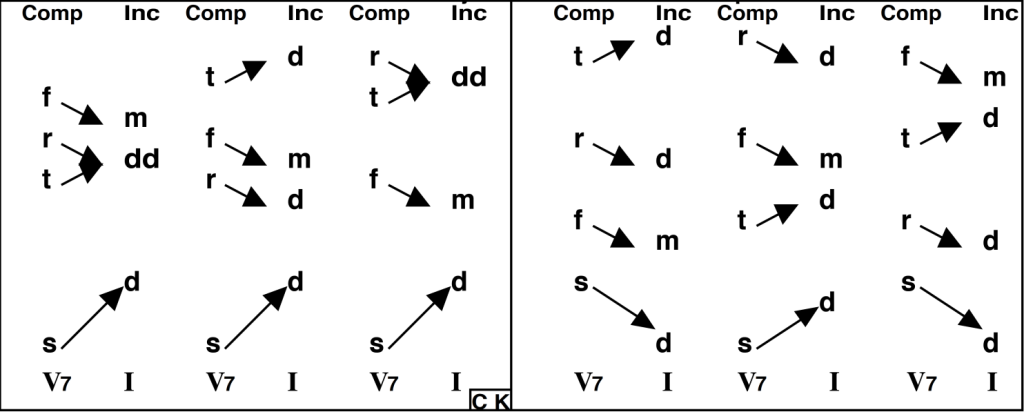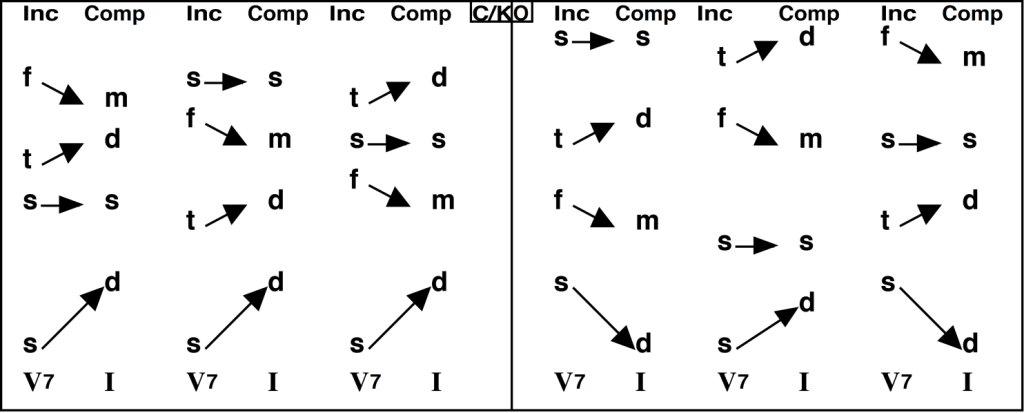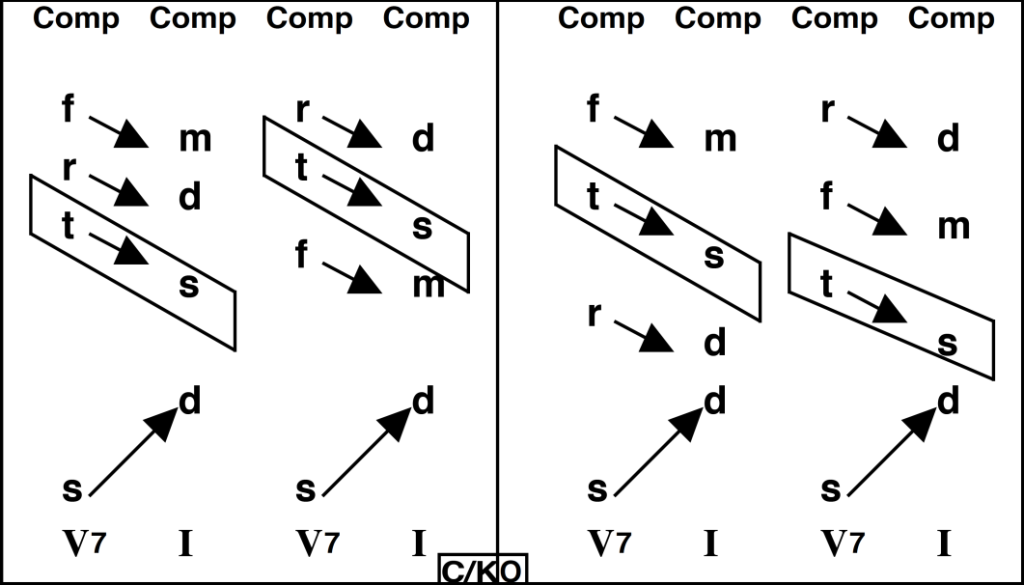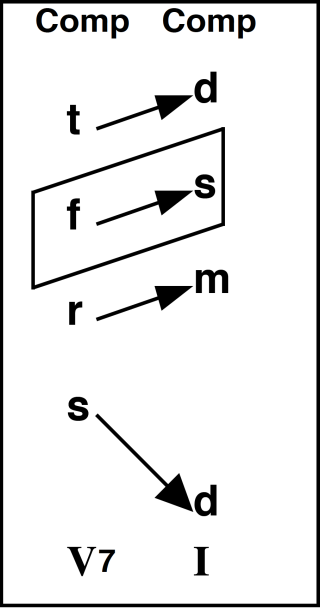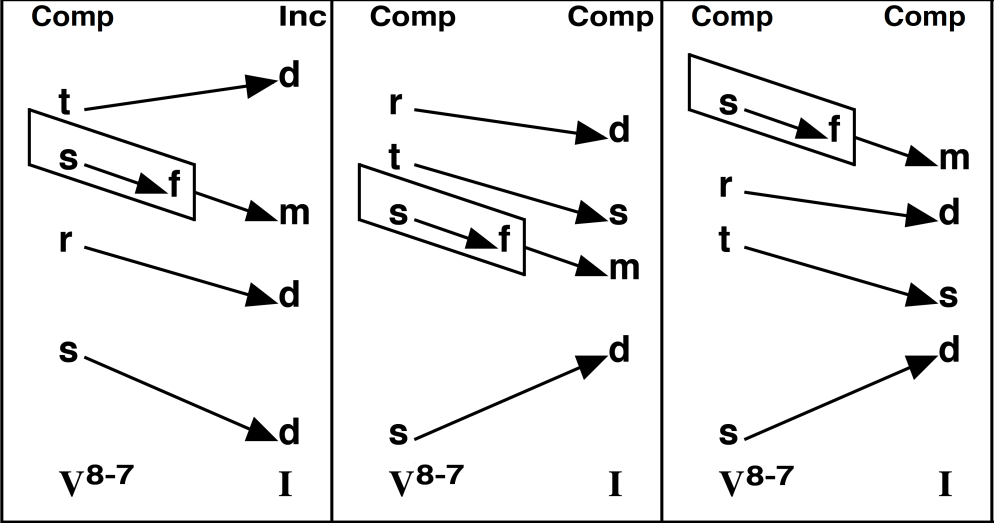4 Dominant Seventh Chord in Root Position
The dominant seventh chord is the same in parallel keys:

A V7 chord with all four notes (so–ti–re–fa) is a complete V7 chord (Comp).
The V7 chord without the 5th (re) and with a doubled root (so–so–ti–fa) is an incomplete V7 chord (Inc).
The dominant seventh chord contains two dissonant intervals, the m7/M2 and A4/d5 (tritone). The interval from the root to the 7th is a m7. The interval from the 3rd to the 7th is a tritone. The m7/M2 and A4/d5 resolutions in major are shown below.
How to resolve dissonances in the dominant seventh chord
strict and free Resolutions of dominant seventh chords
A. Strict Resolution
In strict resolution, one of the two chords will be incomplete. In strict resolution, always move ti to do and fa to mi (me in minor).
1. Complete to Incomplete. The complete V7 resolves to an incomplete I chord with tripled roots (f – m, t – d, r – d in the upper voices; s – d in the bass).
2. Incomplete to Complete. The incomplete V7 chord has two roots, 3rd, 7th, and no 5th, and resolves to a complete I chord (f – m, t – d, s – s in the upper voices; s – d in the bass).
*In actual notation the unison doubling is not shown, resulting in what looks like a chord with only three voices. The examples throughout this book, however, show the two notes on either side of the stem. In choral writing, the stems of the shared notes are split.
B. Free Resolution
In free resolution, both chords are complete. The bass moves in the opposite direction of the upper three voices.
3. Complete to Complete. The leading tone ti in an inner voice drops down to so.
4. Complete to Complete. The 7th of the chord fa in an inner voice (alto or tenor) moves irregularly up to so.
Summary of resolutions
| Tone | Tendency |
| fa | fa is the dissonant 7th, resolving down by step (f – m), except in free resolution when fa moves to so. |
| re | re is not a tendency tone; it can move up by step (r – m) or down by step (r – d). As it is not a tendency tone, it can be dropped out in the case of the incomplete V7 chord (so–so-ti-fa). |
| ti | ti is the leading tone and has a very strong tendency to move up to do, except in free resolution when ti drops to so. |
| so | so leaps either up or down to do |
Voice Leading
Sing the individual parts as shown in the diagrams.
All examples work in major and harmonic minor. All examples can be written in open spacing by moving the alto voice down an octave; maintain an appropriate distance between the bass and the new tenor voice.
1. Strict resolution (complete to incomplete)
Omit the 5th and triple the root in the incomplete I chord.
2. Strict resolution (incomplete to complete)
Omit the 5th and double the root in the incomplete V7 chord.
3. Free Resolution
In a complete-to-complete resolution, one of the two tendency tones will be resolved irregularly.
3a. Free resolution (complete to complete) by moving ti to so
If ti is in an inner voice (the alto or tenor), it can drop down a third to so.
3b. Free resolution (complete to complete) through irregular resolution of the 7th
If fa is in an inner voice, it can move up by step to so.
4. The passing 7th
The doubled root steps down (s – f – m) resulting in a complete V7 chord that resolves by either strict or free resolution.
Approaching V7
- Both contrary motion and common tone connection are possible when moving from I – V7.
- Use common tone connection between IV – V7 Inc. to avoid parallel P5ths.
